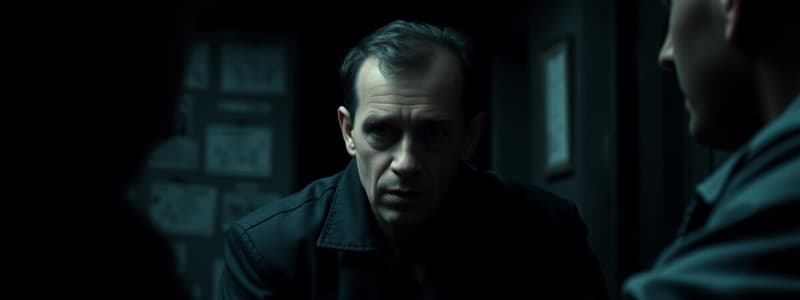Podcast
Questions and Answers
What does the differential association theory primarily focus on in relation to criminal behavior?
What does the differential association theory primarily focus on in relation to criminal behavior?
- Media exposure as a significant influencer
- Socio-economic status as the main factor
- Interactions and relationships with others (correct)
- Genetic predisposition to crime
How does Sutherland define white-collar crime?
How does Sutherland define white-collar crime?
- Violent crimes in organized crime syndicates
- Fraud and financial crimes by people in positions of power (correct)
- Crimes committed by individuals in lower socio-economic classes
- Cyber crimes perpetrated by anonymous entities
According to deterrence theory, what primarily influences an individual's decision to commit a crime?
According to deterrence theory, what primarily influences an individual's decision to commit a crime?
- Cultural norms and values
- Fear of punishment and its avoidance (correct)
- A desire for social status
- Influence from peer groups
Which film is used as an example to illustrate the concept of white-collar crime?
Which film is used as an example to illustrate the concept of white-collar crime?
What does the relationship between organized crime and differential association theory mainly highlight?
What does the relationship between organized crime and differential association theory mainly highlight?
What aspect of crime does the exploration of different criminological theories reflect?
What aspect of crime does the exploration of different criminological theories reflect?
In what year was the deterrence theory introduced by Stafford and Warr?
In what year was the deterrence theory introduced by Stafford and Warr?
What does the differential association theory suggest about the source of criminal behavior?
What does the differential association theory suggest about the source of criminal behavior?
What generalization can be made about various criminological theories throughout history?
What generalization can be made about various criminological theories throughout history?
Which of the following is NOT a characteristic of deterrence theory?
Which of the following is NOT a characteristic of deterrence theory?
What was the primary belief of the demonic perspective in relation to crime?
What was the primary belief of the demonic perspective in relation to crime?
According to classical theory, what motivates individuals to refrain from committing crimes?
According to classical theory, what motivates individuals to refrain from committing crimes?
What characteristic did Lombroso associate with criminal behavior in his positivist theory?
What characteristic did Lombroso associate with criminal behavior in his positivist theory?
In which societal condition does the anomie theory suggest crime thrives?
In which societal condition does the anomie theory suggest crime thrives?
Which film illustrates the concept of strain theory, where a character resorts to crime out of necessity?
Which film illustrates the concept of strain theory, where a character resorts to crime out of necessity?
Cesare Beccaria's classical theory raises philosophical questions primarily about what aspect of human behavior?
Cesare Beccaria's classical theory raises philosophical questions primarily about what aspect of human behavior?
What modern practice reflects the remnants of Lombroso's positivist theory?
What modern practice reflects the remnants of Lombroso's positivist theory?
The strain theory argues that individuals may resort to criminal behavior due to what primary factor?
The strain theory argues that individuals may resort to criminal behavior due to what primary factor?
Which perspective was prevalent until the 1700s and linked crime to evil spirits?
Which perspective was prevalent until the 1700s and linked crime to evil spirits?
In Merton, Rosenfeld, and Messner's theories, the term 'anomie' generally refers to what?
In Merton, Rosenfeld, and Messner's theories, the term 'anomie' generally refers to what?
Flashcards are hidden until you start studying
Study Notes
Criminological Theories in Film and Media
- Historical perspectives on crime evolved from supernatural explanations to modern interpretations and theories.
The Demonic Perspective
- Prevalent until the 1700s, attributing crime to supernatural forces like possession or witchcraft.
- Individuals seen as influenced by evil, leading to extreme measures such as public torture or execution.
- Reflects societal fears and misconceptions regarding crime and morality.
Classical Theory
- Introduced by Cesare Beccaria in the mid-1700s; posits that individuals act in self-interest to maximize pleasure and minimize pain.
- Emphasizes the need for swift, certain, and severe punishment to deter crime.
- Raises philosophical questions about the inherent nature of humanity.
Positivist Theory
- Proposed by Cesare Lombroso in 1876, attributing criminal behavior to biological factors.
- Describes offenders as "genetic throwbacks" and suggests physical traits can indicate criminal propensity.
- Modern implications evident in practices like racial profiling based on external characteristics.
Anomie and Strain Theories
- Introduced by Merton, Rosenfeld, and Messner in 1938.
- Anomie theory links crime prevalence to societal values prioritizing economic success over family and education.
- Example: In Catch Me If You Can, Frank Abagnale Jr. commits fraud for perceived success.
- Strain theory states individuals may resort to crime when they can't achieve societal goals through legitimate means.
- Example: In Aladdin, the protagonist steals due to survival desperation.
Differential Association Theory
- Developed by Edwin Sutherland and Donald Cressey in 1939; posits that criminal behavior is learned through social interactions.
- Highlights the importance of interpersonal relationships in shaping one’s behavior, particularly in organized crime.
- Example: In The Godfather, Michael Corleone's criminal involvement is influenced by his crime family background.
White-Collar Crime
- Sutherland introduced the concept, focusing on financial crimes by individuals in power, such as politicians and CEOs.
- These crimes typically occur within legitimate business contexts.
- Example: The Wolf of Wall Street portrays Jordan Belfort's fraudulent activities in a brokerage firm.
Deterrence Theory
- Introduced by Stafford and Warr in 1968; suggests individuals refrain from crimes to avoid punishment.
- Builds on classical theory principles, emphasizing punishment avoidance's role in decision-making regarding criminal acts.
Conclusion
- Criminological theories reflect the evolving understanding of criminal behavior, addressing supernatural, biological, and socio-economic factors.
- Movies and television exemplify these theories, making complex concepts more relatable and accessible.
- The exploration of these theories showcases the multifaceted nature of crime and fosters ongoing discussions about its causes and implications.
Studying That Suits You
Use AI to generate personalized quizzes and flashcards to suit your learning preferences.




